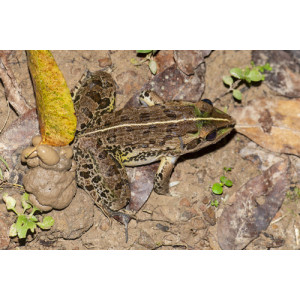Indian Bullfrog Did you see this animal?
Scientific Name : Hoplobatrachus tigerinus
Family : Dicroglossidae
Order : Anura
Class : Amphibia
Phylum : Chordata
Other Name : Indian Bullfrog, Bull Frog, Golden Frog, Tiger Frog, Tiger Peters Frog
Habitat : Almost every type of habitat (wetlands), including salt water.
Description : The Indian Bullfrog, also known as the Asian Bullfrog. These frogs can grow up to 6 inches long and weigh up to 1.5 pounds.
Indian Bullfrogs are typically green or brown in color, with dark spots or patches on their skin. They have strong hind legs and webbed feet, which allow them to jump great distances and swim quickly in water. Indian Bullfrogs have a powerful jaw and sharp teeth, which they use to capture and swallow their prey whole.
They are mostly active at night, but can also be seen during the day basking in the sun to regulate their body temperature.
During the breeding season, male Indian Bullfrogs will stake out a territory and call out to attract females. They will defend their territory aggressively against other males. After mating, the female will lay her eggs in a pond or other body of water. The tadpoles hatch from the eggs and undergo a metamorphosis process before becoming fully grown frogs.
Indian Bullfrogs have a robust immune system and produce antimicrobial peptides in their skin, which protect them from infections and diseases.
These frogs are capable of changing color depending on their environment, which can help them blend in and avoid predators, They are also known for their loud, deep croaking calls, which can be heard from a great distance.
These frogs are found in a variety of habitats, including forests, grasslands, and wetlands. They are omnivores, meaning they eat both plants and animals. Their diet includes insects, small mammals, birds, and even other frogs.
Overall, the Indian Bullfrog is a fascinating and important species that plays a vital role in its ecosystem. As with all wildlife, it is important to appreciate and protect these creatures for future generations to enjoy.
Indian Bullfrogs are typically green or brown in color, with dark spots or patches on their skin. They have strong hind legs and webbed feet, which allow them to jump great distances and swim quickly in water. Indian Bullfrogs have a powerful jaw and sharp teeth, which they use to capture and swallow their prey whole.
They are mostly active at night, but can also be seen during the day basking in the sun to regulate their body temperature.
During the breeding season, male Indian Bullfrogs will stake out a territory and call out to attract females. They will defend their territory aggressively against other males. After mating, the female will lay her eggs in a pond or other body of water. The tadpoles hatch from the eggs and undergo a metamorphosis process before becoming fully grown frogs.
Indian Bullfrogs have a robust immune system and produce antimicrobial peptides in their skin, which protect them from infections and diseases.
These frogs are capable of changing color depending on their environment, which can help them blend in and avoid predators, They are also known for their loud, deep croaking calls, which can be heard from a great distance.
These frogs are found in a variety of habitats, including forests, grasslands, and wetlands. They are omnivores, meaning they eat both plants and animals. Their diet includes insects, small mammals, birds, and even other frogs.
Overall, the Indian Bullfrog is a fascinating and important species that plays a vital role in its ecosystem. As with all wildlife, it is important to appreciate and protect these creatures for future generations to enjoy.
Distribution in Bangladesh
References:
description written by: Md. Shalauddin, Department of Zoology, Jagannath University, Dhaka. Information sources: IUCN Red List Bangladesh-2015, Hasan 2014, Khan 2018 (Photographic guide to the wildlife of Bangladesh).photo credit:Aniruddha Singhamahapatra (www.inaturalist.org/people/Aniruddha Singhamahapatr),photo copyright: iNaturalist. more information please contact with us.
description written by: Md. Shalauddin, Department of Zoology, Jagannath University, Dhaka. Information sources: IUCN Red List Bangladesh-2015, Hasan 2014, Khan 2018 (Photographic guide to the wildlife of Bangladesh).photo credit:Aniruddha Singhamahapatra (www.inaturalist.org/people/Aniruddha Singhamahapatr),photo copyright: iNaturalist. more information please contact with us.






















